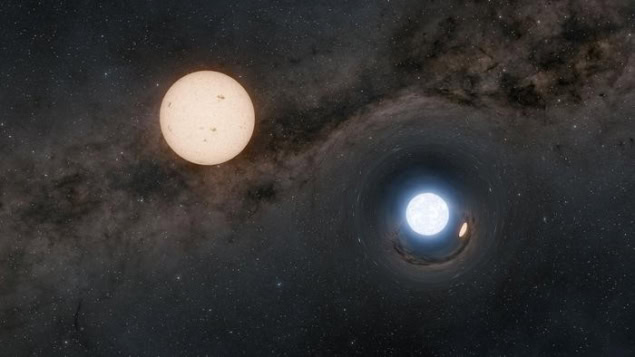
Astronomers have found strong evidence that 21 Sun-like stars orbit neutron stars without losing any mass to their binary companions. Led by Kareem El-Badry at the California Institute of Technology, the international team spotted the binary systems in data taken by ESA’s Gaia satellite. The research offers new insights into how binary systems evolve after massive stars explode as supernovae. And like many scientific discoveries, the observations raise new questions for astronomers.
Neutron stars are created when massive stars reach the end of their lives and explode in dramatic supernovae, leaving behind dark and dense cores. So far, over 99% of the neutron stars discovered in the Milky Way have been solitary – but in some rare cases, they do exist in binary systems with Sun-like companion stars.
In every one of these previously discovered systems, the neutron star’s powerful gravitation field is ripping gas from its companion star. The gas is heated to extreme temperatures as it accretes onto the neutron star, causing it to shine with X-rays or other radiation.
No accretion
However, as El-Badry explains, “it has long been expected that there should be similar binaries of neutron stars and normal stars in which there is no accretion. Such binaries are harder to find because they produce no X-rays.”
Seeking these more elusive binaries, El-Badry’s team scoured data from the ESA’s Gaia space observatory, which measures the positions, distances, and motions of stars with high precision.
The astronomers looked for Sun-like stars that “wobbled” in the sky as they orbited invisible companions. By measuring the wobble, they could then calculate the size and period of the orbit as well as the masses of both objects in the binary system.
El-Badry explains that Gaia is best at discovering binaries with widely separated orbits. “Gaia monitors more than a billion stars, giving us good chances of finding even very rare objects,”
Gravitational influence
In total, Gaia’s data revealed 21 cases where Sun-like, main sequence stars appear to be orbiting around unseen neutron star companions, without losing any material. If this interpretation is correct, it would be the first time that neutron stars have been discovered purely as a result of their gravitational influence.
The researchers predict that these systems are likely to evolve in the future when their Sun-like stars approach the end of their lives. “When the [Sun-like] stars evolve and become red giants, they will expand and begin transferring mass to the neutron stars, so these systems are progenitors of X-ray binaries,” El-Badry says.
On top of this, the sizes of the orbits observed by team could provide clues about the magnitudes of the supernovae that formed the neutron stars. “The wide orbits of the binaries in our sample would get unbound if the neutron stars had received significant kicks during the supernovae from which they are born,” El-Badry explains. “These objects imply that some neutron stars form with weak kicks.”
Could be white dwarfs
The team’s results throw up some important questions about the nature of these binaries and how they formed. For now, it remains possible that the unseen companions could be white dwarfs. These are the remnants of relatively small stars like the Sun – stars that have exhausted their nuclear fuel and then fade out, rather than exploding to form neutron stars.

Gaia releases most detailed maps of the Milky Way ever taken
If a companion is indeed a neutron star, its progenitor star would have experienced a red supergiant phase before going supernova. This would have created an envelope of gas large enough to affect the binary system. It is not clear why the two stars would not have drawn much closer together or even merged during this phase. Later, when the larger star exploded, it is not clear why the two objects did not go their separate ways.
El-Badry’s team hope that future studies of Gaia data could answer these challenging questions and explain how these curious binary systems form and evolve.
The observations are described in The Open Journal of Astrophysics.



